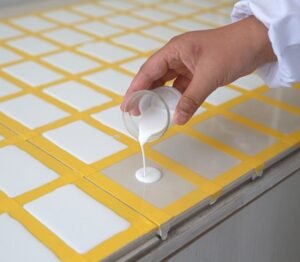As critical additives in construction chemicals, food processing, and industrial formulations, starch ether and cellulose ether are often hailed for their thickening, stabilizing, and modifying properties. However, their distinct molecular structures and functional characteristics make them uniquely suited to specific applications. This article dissects the core differences between these two polysaccharide derivatives, shedding light on how their properties drive performance in diverse industrial scenarios.
Functional Performance: Anti-Sagging, Slip Resistance, and Beyond
A defining distinction lies in their ability to enhance material workability. Starch ether excels in improving anti-sagging and anti-slip properties in mortar systems-key attributes in applications like tile adhesives, plaster, and rendering mortars. Its molecular design enables the formation of a structured network that resists deformation under stress, preventing mortar from sliding during application, especially critical for large-format tile installation or vertical surfaces.
In contrast, cellulose ether primarily focuses on viscosity enhancement and water retention. While it strengthens the cohesive force of mortar by increasing viscosity (critical for preventing water loss in porous substrates), it does not contribute significantly to anti-sagging performance. This functional divide makes starch ether indispensable in scenarios requiring both workability and shape retention.
Thickening Mechanisms: Viscosity Does Not Equal Efficacy
Viscosity values alone fail to capture the full picture of their thickening capabilities. Cellulose ether typically exhibits high viscosity, ranging from tens of thousands of mPa·s, due to its long, linear molecular chains that entangle extensively in aqueous solutions. Starch ether, by contrast, has lower viscosity (hundreds to thousands of mPa·s) but operates via a distinct mechanism: its branched molecular structure induces thixotropic behavior, where viscosity decreases under shear (e.g., during mixing) and recovers when shear is removed. This makes starch ether highly effective in controlling flow properties in dynamic applications, such as pumped mortar, where cellulose ether’s high static viscosity may hinder processability.
Tile Adhesive Performance: Initial Yield Value as a Game-Changer
In tile adhesive formulations, starch ether’s ability to boost initial yield value is a standout advantage. The initial yield value-resistance to deformation under low stress-determines how well the adhesive holds tiles in place immediately after application. Starch ether enhances this parameter, preventing tile slippage even with large or heavy tiles, a critical factor in modern construction. Cellulose ether, while improving overall cohesion, does not significantly impact initial yield value, making starch ether the preferred choice for high-performance tile installations.
Air-Entraining Properties: A Double-Edged Sword
Cellulose ether is known for its strong air-entraining effect: its molecular structure traps small air bubbles in aqueous solutions, which can improve mortar workability but may reduce compressive strength in structural applications. Starch ether, conversely, has no air-entraining properties, making it ideal for formulations where low porosity and high mechanical strength are required, such as load-bearing concrete or high-strength grouts. This difference allows formulators to tailor air content precisely, balancing workability and structural performance.
Molecular Structure: The Root of Functional Diversity
At the molecular level, both starch and cellulose are composed of glucose units, but their linkage orientations drive profound differences. Starch consists of glucose monomers linked in a unidirectional orientation, forming linear (amylose) and branched (amylopectin) chains with weaker intermolecular forces. Cellulose, by contrast, features alternating glucose orientations-each adjacent monomer flips 180 degrees-creating strong hydrogen bonds between molecular chains. This structural rigidity makes cellulose ether more resistant to enzymatic degradation and thermal stress, while starch ether’s structure enables its unique thixotropic and anti-sagging properties.
Conclusion: Choosing Based on Application Demands
Starch ether and cellulose ether are not competing additives but complementary tools, each excelling in specific scenarios. Starch ether shines in applications requiring anti-sagging, controlled flow, and low air entrainment-such as tile adhesives and vertical mortars. Cellulose ether, with its superior water retention and high viscosity, remains irreplaceable in formulations prioritizing cohesion and moisture management. By understanding their structural and functional differences, industry professionals can select the optimal additive, ensuring enhanced product performance and process efficiency.



